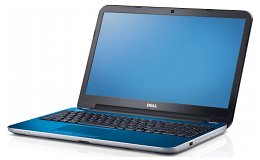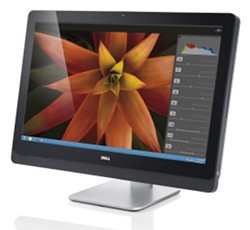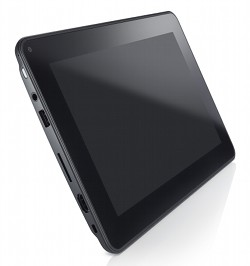Blog posts tagged Dell
Dell XPS 10 review: a great business tablet with one Achilles' heel

Light and slender, Dell's XPS 10 tablet computer looks like a small laptop, except the optional keyboard (not pictured) can be removed, transforming it into a pure 10.1" touch screen tablet.
We spent a couple of days using the XPS 10. Here are our first impressions.
Solid and weighty
Buying the XPS 10The XPS 10 is available direct from Dell. There are several models to choose from. Prices start from £299 for the entry-level model with 32GB of storage and no keyboard. The top-end model is £444, including the keyboard. See options and buy online >> |
The XPS 10 is an attractive, understated piece of kit. It feels solid and - when you choose to use it - the keyboard is pleasant and quiet, if a little undersized.
It would be nice if the keyboard had a backlight, but the large trackpad works nicely without feeling at all cramped.
Because the keyboard contains extra batteries, when you use the XPS 10 in its 'laptop' configuration, the battery life is fantastic. It'll keep going for 16+ hours, which is great if you're on a long flight or simply don't want to recharge so often.
However, the flipside of this staying power is the significant weight of the keyboard. In pure tablet mode, the Dell XPS 10 weighs in at 635g, which is slightly less than an iPad. But adding the keyboard more than doubles this to 1.3kg.
A well-connected tablet
The XPS 10 impresses with its connectivity too. The screen includes a micro-USB port and micro-SD memory card slot, as well as the dock connector for the keyboard. When the keyboard isn't attached, this doubles as an HDMI output via an adaptor, allowing you to connect an external screen when in tablet mode.
There are extra ports on the keyboard, including two USB connections and a mini-HDMI port, for hooking up screens and projectors.
The touch screen is clear and bright - even in sunlight - and allows multi-touch gestures just like a decent tablet should. It responds well when you tap and swipe, comparing favourably with other tablets in this bracket.
Adequate storage, good performance
The XPS 10 includes either 32GB or 64GB (gigabytes) of storage space. That's not a huge amount, particularly when you realise the pre-loaded software can leave as little as 16GB of usable space on the smaller-capacity model.
It is still room for lots of text documents or thousands of images. However, it would be wise to avoid downloading large video or music files, as these could eat up that space quickly.
Overall, the XPS 10's performance certainly feels snappy. Chuck in the enormous battery life and this Dell tablet starts to look like a real winner.
Is Windows RT enough?
The XPS 10's Achilles' heel is that it comes with Microsoft Windows RT, a special version of Windows designed for tablets.
The problem with Windows RT is that it can't run most standard Windows software. That means some of the programs you use in your business are unlikely to work on the XPS 10.
The tablet does come with a web browser, email software and other tools which mean it's fine for browsing the internet and using many cloud services. There's also an app store where you can download apps that will work on the tablet, although it's sparsely populated compared with competing app stores from Apple and Android.
Most usefully, the XPS 10 includes a special version of Microsoft Office, meaning you can work on Word, Excel and PowerPoint documents.
However, when you buy the tablet you'll get the Home & Student Edition of Office, which is not licensed by Microsoft for commercial use. As ZDNet has revealed, you'll need to buy an additional commercial license to legally use this version of Office in your business.
It's worth noting this isn't really Dell's fault. Microsoft hasn't made other versions of Office available with Windows RT. But it still seems bizarre that a tablet specifically marketed as being 'great for work and play' comes with key software that you can't legally use for work.
Our conclusionThe Dell XPS 10 is a nicely-built tablet with a brilliant battery life. It has few weak points when used in either tablet or laptop modes, and during our limited time with it we've been impressed. But whether it's right for you will probably come down to whether you can manage with Windows RT. It's confusing to use a version of Windows that doesn't run your existing software and the limited-but-expanding range of apps could be a source of frustration. (In fact, one of Dell's competitors, Samsung, has cancelled its Windows RT tablets.) As a tablet for internet and email then the XPS 10 is an excellent piece of kit. If you're happy to pony up for a commercial Microsoft Office license and the other apps you need are available for Windows RT then it could be a great addition to your business. Just make sure you're comfortable with the software's limitations before you make the leap. Get more details and buy online from Dell >> |
Dell launches new everyday business laptops
 At this year's Consumer Electronics Show (CES) in Las Vegas, Dell announced new models in its Inspiron laptop range.
At this year's Consumer Electronics Show (CES) in Las Vegas, Dell announced new models in its Inspiron laptop range.
Although the PC giant's machines are a fixture in companies across the world, there are suggestions that laptop sales are in a long-term decline. So, can these new models tempt workers away from their tablet computers?
Thin, light and powerful?
Dell's customers told it that they want better battery life from laptops without sacrificing overall performance, and that they want laptops that are thin and portable.
That's not exactly groundbreaking news, but as a result the company says its new Inspiron models take advantage of low-power processors to optimise performance and improve battery life. They're 17% thinner and 15% lighter than the previous generation.
Budget-friendly options
The Dell Inspiron 15 and Inspiron 17 models are designed for budget-conscious customers looking for a laptop with all the usual essential features.
Prices start at just £299 all in for the entry-level 15" model. But with its slow Celeron processor, it's a false economy. Even if you're on a really tight budget, you'll be better off stretching to £379 for a model with Intel's i3 processor.
Unusually for a laptop this size, the 15" model includes a 10-key number pad, which could be really useful if you enter numbers or work with figures a lot.
If you prefer a bigger screen (but a less portable laptop), the 17" model starts at £349. Again, a decent business machine will cost you more than that - here aim for the £449 model which includes a powerful Intel i5 processor.
Pay more for personalisation
There are also two more expensive models in the range: the Inspiron 15R and 17R.
These offer some personalisation options, including a choice of brushed-aluminium finishes. Lovely, but probably not worth paying more for.
Of more interest is the optional full HD screen available with these two laptops. This gives you a crisper display, with more space for your windows and the ability to show full HD video if you wish.
It's not a must-have for business use, but may be worth paying extra for, particularly if you use your laptop screen a lot to work on big images, spreadsheets or other documents that take up a lot of space on screen.
For a full HD screen, you're looking at paying £679 for the 15" model, or £699 for the 17" model.
Dell Vostro 3560 business laptop review

Dell's Vostro range of laptop and desktop computers is aimed specifically at smaller businesses. We got our hands on the company's 15" Vostro 3560 laptop, and tried using it day-to-day in our company. Read on to see what we thought.
Design, size and weight
The Vostro 3560 has a pleasing appearance and a sleek, classy look to it. As with many laptops, the outside of the case is made of metallic-effect plastic. We'd prefer it to be actual metal, but that was probably outside Dell's budget.
Having said that, it looks and feels solid. The matte grey plastic around the screen is a little thicker than we'd like, but the overall effect is great.
At 2.57kg, the Vostro weighs about average for a laptop of this size. It's fine for mobile working now and again, even though it's not super-light.
The keyboard is well-spaced, making it harder to hit the wrong keys, even if you have sausage fingers. It has a positive action and is nice and quiet, so you can type for extended spells without having to connect an external keyboard.
In line with recent trends, there's a nice large trackpad with two wide buttons. You can scroll using two fingers on the trackpad, rather than having to click and drag scroll bars on screen.
Display
The 15.6" display is bright, and lacks a glossy coating, which makes it well-suited to use under bright lights. You can see the screen clearly from a wide viewing angle, so this could be a good laptop for giving ad-hoc presentations in meetings.
The version we tested had a crisp, clear full-HD screen, so you can watch HD video on it at the full resolution. It's also available with a lower-resolution screen.
Performance
The Vostro 3560 we tested had an Intel i5 processor. It was well up to anything we threw at it during day-to-day business use. It's well-suited to running apps like Microsoft Word and Outlook, or running several programs at once.
We tested it using Windows 7, which loaded in under 30 seconds. The 3560 now ships with Windows 8.
The model we tested had an optional dedicated graphics card. This makes a big difference to the graphics performance and is a good option if you want to play games or run graphics-intensive software like Photoshop.
It's worth noting that the base level model only comes with 2GB (gigabytes) of RAM, which is borderline adequate nowadays. You can upgrade after buying, or opt for a model with 4GB, 6GB or 8GB instead.
Storage and connections
Even the entry-level Vostro 3560 comes with a 320GB (gigabyte) hard drive, which should provide more than enough storage for general business use. There's also a built-in DVD writer, so you can read and burn DVDs easily.
There are a generous 4 USB connections, all of which are the fastest USB3 type, so they can transfer data nice and quickly. The connectors are close together, which means a chunky memory stick or mobile broadband dongle can block the adjacent ports.
You can also connect external displays or a projector via VGA and HDMI ports.
Vostro 3560 conclusions
We really enjoyed using the Vostro 3560 for a few days. It has a classy, solid feel that belies its price, and it's more than capable in a business context.
True, it's not incredibly light, and it lacks the touch screen features appearing on other laptops. However, performance is good, the screen is excellent and with an entry-level price of £299 (plus VAT and shipping), it represents great value for money.
Buying the Dell Vostro 3560The Dell Vostro 3560 is available direct from Dell. Prices start at £299 + VAT and shipping. The £479 mid-range model looks like excellent value. Get 10% off when ordering online from Dell.co.uk by using the promotional code H3983?MGC4XBL4 |
Microsoft wants every computer to have a touch screen
 We're just over a week away from the full launch of Windows 8, the new version of Microsoft's Windows operating system.
We're just over a week away from the full launch of Windows 8, the new version of Microsoft's Windows operating system.
It can be hard to predict how a Windows launch will go. Your computer's operating system isn't something that gets your average person excited in the same way that a sleek new smart phone or laptop might. So don't expect to see big queues at your local PC World.
But on the other hand, Windows 8 promises some fundamental changes to the way Windows works, virtually guaranteeing media coverage for Microsoft on 26 October, which is when it all happens.
A Microsoft gamble
It's a big gamble for the software giant, which is betting people will be willing to adapt to a new interface that's been designed to be easier to use on touch screen devices like tablets.
The changes haven't been universally praised so far. Some testing suggests that while the interface works well if you have a touch screen, it can be fiddly if you don't.
Touch screens for everyone
Central to Microsoft's approach is the idea that touch screens aren't just for tablet computers and smart phones. When most computers have touch screens, so the theory goes, Windows 8 will really start to show what it can do.
And, of course, as Microsoft touts the touch-enabled features in Windows, some computer manufacturers are making hardware to take advantage of them.
Take Dell. It's just announced a couple of new touch screen computers which might appeal to businesses looking to test touch screen technology:
- The XPS 12 Convertible is a super-light ultrabook with a 'flip and fold' screen that enables you to hide the keyboard and convert it into a tablet. Might be good for that wow factor at meetings. At £999 it's not cheap, but compares reasonably with other ultrabooks.
- The XPS One 27 (picutred) is an all-in-one desktop machine. A single unit contains a touch screen monitor and all PC components. It's a powerful desktop machine with a £1700 price tag to match. The value of a touch screen in this sort of machine is less obvious (maybe it's good for point-of-sale situtions and exhibition stands?), but perhaps the features of Windows 8 will make its usefulness clearer.
Expect these computers to be the first of many with touch screens. That only leaves one question: will we find them useful?
|
You can pre-order the Dell XPS 12 Convertible and XPS One 27 now. |
Windows 8 to spark tablet war?
 It's rather got lost in all the recent hype over iPhone 5, but Windows 8 - the next version of Microsoft's dominant operating system - will be available from 26 October.
It's rather got lost in all the recent hype over iPhone 5, but Windows 8 - the next version of Microsoft's dominant operating system - will be available from 26 October.
It can be a risky business being first to adopt a new Windows version. As with any major new software, there are usually a few bugs that need ironing out. Canny companies hold off upgrading until these teething problems are solved.
Windows on a tablet
Having said that, a big Windows 8 push is just round the corner. And it's not just from Microsoft. There are plenty of hardware companies hoping Windows 8's innovative new interface and touchscreen features will drive up their sales too.
What's more, Windows 8 is the first version of Windows to cater seriously for tablet computers. There will be lots of new features to take advantage of touchscreens, and so one exception to the 'don't be first to buy it' rule might be if you want a new tablet computer.
A new tablet from Dell
Take Dell. Anticipating a Windows 8 buzz, the hardware giant has just announced a new tablet that'll launch on the same day as Windows 8. It's the Latitude 10, and it promises to make the most of the tablet-focused features in Windows 8.
Done right, a Windows 8 tablet could be ideal for smaller companies. It should give them all the convenience of a tablet without requireing them to learn how to use lots of new software, or convert files between different formats.
Sure, our experiences with Windows 7 tablets have been underwhelming, but initial reports suggest Windows 8 will be an entirely different beast.
Security in a crowded market
Expect tablets like the Latitude 10 to be of particular interest to companies which handle lots of sensitive data. Dell's tablet puts a big emphasis on security, with support for two-factor authentication. This means you need something you know (like a password) and something you have (like your fingerprint or a smart card) to log in.
But it will be a crowded market. There's Apple's iPad (from £399), of couse. But recent months have seen Google (from £159) and Amazon (from £129) launch keenly-priced tablets. Even Microsoft will be launching a Windows 8 tablet. As Windows 8 draws closer, more Windows tablets will join the fray.
This all means now's a great time to keep an eye on the market, particularly if you like the idea of having a tablet but aren't quite convinced yet. Windows 8 will prompt new models, extra competition and - with luck - some aggressive pricing and innovative features.
How your business is evolving
 Work attitudes and practices are evolving rapidly, fuelled by advances in technology and widespread broadband connectivity.
Work attitudes and practices are evolving rapidly, fuelled by advances in technology and widespread broadband connectivity.
Indeed, perhaps it’s the availability of fast internet connections which is enabling information, ideas and knowledge to flow freely.
Our world of work is being redefined. With it, the expectations of workers and managers in businesses of all sizes are being challenged.
The evolving workforce
To understand how working habits are changing and the impact this will have on companies across the globe, Dell and Intel commissioned a piece of research: The Evolving Workforce. We wanted to learn how the way businesses work is changing.
Part of the research involved polling the workforce itself – approximately 8,000 workers in 11 countries, 1,000 of whom were based in the UK. The results contain some interesting findings for smaller businesses:
- Smaller businesses offer better job stability. Worldwide, employees of small and medium-sized businesses feel their jobs are safe from external threats. They feel stable in their roles; only 25% feel that outsourcing is a threat.
- Smaller companies offer greater job satisfaction. Generally, employees of small and medium-sized businesses are happier at work than people in larger companies. Some employees say this is because they’re able to choose the technology they use. In small and medium-sized businesses, 39% of employees can choose their IT, compared with just 21% at larger companies.
- Employees in smaller businesses are more trusted by their employers. Results from around the world show that 55% of employees from small and medium-sized businesses say they feel their employer listens to them, compared to only 36% at larger companies.
- People working for small and medium-sized businesses have more flexibility and choice in the devices they use. 42% of employees at small and medium-sized companies in Japan believe they’re consulted about technology choices, yet only 31% had positive views of their IT support.
The figure is similar in Mexico, with 40% being more likely to choose their own devices, compared with half that (20%) in large enterprises. This shows how smaller businesses are able to offer more flexibility – an attractive prospect to employees who like to choose the technology they use every day.
Small and medium-sized businesses are blazing a trail in terms of employee-led innovation, but results from our survey suggest the UK lags behind. More than half (53%) of employees say they don’t have the freedom to choose how to work.
By giving workers increased freedom, offering flexible working and a choice of devices, small and medium-sized businesses will increase motivation and, in turn, boost productivity and creativity to stimulate further innovation and growth.
Kevin Peesker is General manager Dell UK and Ireland small and medium business



